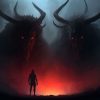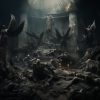Demons have been a topic of intrigue, fear, and fascination throughout cultures and history. Religious texts, literature, and media have explored these evil entities’ concepts, shaping our understanding and interpretation of demons.
But what exactly is a demon? Is it an evil spirit, a fallen angel, or something far more complex? This comprehensive exploration delves into the multifaceted world of demons, their origins, interpretations, and their role in various aspects of human life.
Understanding The Term ‘Demon’
The word ‘demon’ has ancient roots, tracing back to the Greek word ‘daimōn,’ which referred to a deity or divine power. Originally, this term didn’t carry the negative connotations it does today. Instead, it was used to describe lesser spirits that could be benevolent or malevolent.
The Word ‘Demon’: Its Origins and Meanings
In Ancient Greek, ‘δαίμων’ (daimōn) denoted a spirit or divine power, not necessarily evil. Over time, the meaning of this word evolved, mainly influenced by Jewish and Christian writers who began associating it with evil spirits or fallen angels. This shift in meaning was further solidified in the New Testament of the Bible, where ‘daemon’ was used to refer to evil supernatural beings opposed to God’s will.
The English language adopted the term from the Late Latin ‘daemōn,’ an evil soul or spirit, which was itself derived from the Greek ‘daemon.’ In its current sense, the word ‘demon’ made its way into Middle English, denoting an evil spirit or devil.
How the Word ‘Demon’ Has Evolved
The word ‘demon’ evolution reflects changes in cultural and religious beliefs over centuries. As societies transformed, so did the interpretation of what a demon represents. The ancient Greek concept of ‘daemon’ was initially neutral, referring to a divine influence that could shape a person’s character or fate, much like the Roman concept of a ‘genius’ or guiding spirit.
However, under the influence of Jewish and Christian writers, ‘daimon’ came to be associated with evil and darkness. These writers depicted demons as fallen angels cast out of heaven for rebelling against God. In this context, demons were seen as evil beings intent on leading humans astray.
In the book “Hostage to the Devil: The Possession and Exorcism of Five Contemporary Americans,” author Malachi Martin provides chilling accounts of demonic possession, further cementing the modern perception of demons as evil entities.
As we continue to explore the concept of demons, we’ll delve deeper into their cultural, religious, and psychological interpretations, offering a comprehensive look at these intriguing yet terrifying entities.
Demons: A Cultural Perspective
As evil entities, demons have been a part of folklore and belief systems worldwide. They are often seen as evil forces, causing harm to humans and embodying the darker aspects of the world. However, their characteristics, abilities, and roles vary widely from culture to culture.
Demons in Different Cultures: Common Themes
From ancient Hinduism to indigenous cultures of the Americas, demons appear as disruptive forces. They are often associated with death, illness, misfortune, and the underworld. Despite cultural variations, common themes emerge. Monsters are typically depicted as powerful, feared beings with abilities to influence or control aspects of the created world.
In “The Encyclopedia of Demons and Demonology,” author Rosemary Ellen Guiley extensively analyzes demons across different cultures, illustrating the global prevalence of these supernatural beings.
The Concept of Demons in Western Culture
In Western culture, influenced heavily by Christian beliefs, demons are often portrayed as fallen angels, cast out of heaven for rebelling against God. They are seen as tempters seeking to lead humans away from righteousness.
Eastern Perspectives on Demons
Eastern cultures also have rich demonologies. In ancient Hinduism, for instance, demons (asuras) are often depicted in conflict with the gods (devas), symbolizing the eternal battle between good and evil.
The Latin Origin of Daemōn
The Latin term “daemōn” evolved from its precursor, the Ancient Greek “daimon.” While the Greeks viewed the “daimon” as a spiritual being of a neutral or even benevolent nature, the concept underwent a significant transformation when it transitioned into Latin usage.
The early Christian Church played a significant role in this transformation. As Christianity began to shape Western culture and religious beliefs, the term “daemōn” was co-opted to embody the concept of evil entities. The original Greek conception of spiritual beings who could influence divine nature and human destiny was replaced with the idea of wicked spirits working against the divine plan.
The Latin “daemōn” was thus reimagined as an evil spirit, a corruptor, and a deceiver working against God and seeking to lead humans away from righteousness. The Latin interpretation heavily influenced the concept of demons in Christianity, where they are seen as fallen angels cast out of Heaven due to their rebellion against God.
Daemōn as an Evil Spirit: Interpretations and Beliefs
While the term “daemon” or “demon” has come to be widely associated with evil due to its usage in Christianity, its interpretation and connotations can vary significantly across different cultures and belief systems.
In many belief systems, these entities are seen as tempters, instigators of sin, and causative agents of disaster, illness, or misfortune. They are often portrayed as adversaries to humanity; their evil influence constantly tests a person’s faith and virtue.
However, there is also an alternative view that casts these entities in a more complex light. In his book “Daimonic Reality: A Field Guide to the Otherworld,” British author Patrick Harpur suggests a more nuanced interpretation of these entities. He proposes that daemons can be seen as personifications of archetypal energies, symbols, or processes, integral parts of the human psyche, and the collective unconscious.
In Harpur’s view, the concept of the ‘daemonic’ encompasses a spectrum of experiences and phenomena beyond human form that transcend the boundaries of ordinary reality. This could include everything from visionary experiences and mystical encounters to the manifestations of the human imagination and subconscious mind.
Through this lens, ‘daemons’ or ‘demons’ are not just simple embodiments of evil, but complex manifestations of the human psyche and spiritual experiences, whose nature can be as enlightening as it can be terrifying.
The evolution of the term ‘demon,’ from its ancient Greek origins to its Latin reinterpretation, provides a fascinating insight into how cultural, religious, and philosophical influences shape our understanding of supernatural entities. And as we continue to explore their multifaceted representations in various cultures, spiritual traditions, and literary works, we gain a deeper appreciation of their roles in reflecting and shaping human fears, desires, and understanding of the cosmos.
The Nature of Demons: Evil Spirits
The common perception of demons as evil spirits pervade numerous cultures and religions worldwide. Seen as supernatural entities, they are often depicted as beings with malicious intent, striving to cause destruction, chaos, and despair.
From the Christian perspective, demons are considered fallen angels, cast out of Heaven for rebelling against God. In other cultures and traditions, demons are seen as malignant spirits or entities from the underworld or other supernatural realms. Regardless of their origin, the consistent theme across various belief systems is their tendency to inflict harm, manipulate, and sow discord.
Characteristics of Demons: The Epitome of Evil
In their portrayal as the epitome of evil, demons are often endowed with characteristics that symbolize darkness, fear, and the inversion of moral and social norms. They are frequently linked with domains associated with death and the underworld, opposing life, light, and order.
Demons are typically depicted as mighty beings possessing various supernatural abilities. A common belief is their capacity to maintain or influence humans, pushing them towards sinful acts, destructive behavior, or negative emotions. This power to corrupt the righteous path and distort human behavior further solidifies their role as embodiments of malevolence.
Moreover, visual representations often portray demons with grotesque or terrifying appearances to emphasize their evil nature. These visual cues can range from monstrous forms to eerily human-like appearances with distinct, unnerving features.
The Powers and Abilities of Demons
The exact nature and extent of the powers attributed to demons greatly depend on the cultural or religious context. However, some abilities seem to be universally acknowledged across different traditions.
Shape-shifting, or the ability to alter their physical form, is a commonly attributed power. Demons are often believed to be capable of presenting themselves in various forms, from horrific monsters to attractive humans, animals, or even inanimate objects. This power enhances their capacity to deceive and manipulate.
Possession or the power to control humans is another prominent ability. Through possession, demons are believed to exert direct control over a person’s actions, thoughts, or emotions, often leading to harmful or destructive outcomes.
Demons are also often associated with causing disease, misfortune, or natural disasters. They’re believed to have the power to afflict individuals with illnesses or inflict communities with plagues and calamities, symbolizing their chaotic and destructive nature.
In certain traditions, demons and devils are also attributed to controlling specific elements, realms, or aspects of nature. These powers highlight their potential to affect the world in tangible ways and their crucial role in the cosmological balance of good and evil.
As we delve into the fascinating world of demonology, we must remember that these characteristics, abilities, and the concept of ‘demons’ can vary greatly. They are shaped by myriad cultural, religious, and socio-historical influences and can offer us profound insights into human fears, beliefs, and the enduring struggle between good and evil.
Inner Demons: A Psychological Perspective
The term ‘inner demons’ is often used metaphorically in modern language, representing personal struggles, fears, or negative aspects of one’s personality.
Understanding Inner Demons: The Metaphorical Demons We Battle
Inner demons can represent anything from mental health issues, such as anxiety and depression, to personal vices or harmful habits. Battling one’s inner demons is a common theme in literature and media, symbolizing the human struggle for self-improvement and inner peace.
Coping with Inner Demons: Strategies for Overcoming Personal Struggles
Addressing and overcoming inner demons is a significant part of personal growth and mental health. This often involves acknowledging personal flaws or fears, seeking professional help when necessary, and implementing strategies for positive change.
As we continue to explore the concept of demons, we will look at their role in religion, their depictions in literature and media, and the debates surrounding their existence. Each perspective offers unique insights into our understanding of what demons are.
Demons in Religion
Religion often provides a framework for understanding good and evil. In many religions, demons are seen as agents of darkness, working against divine powers.
Demons in Christianity: Fallen Angels and Temptation
In Christian theology, demons are often portrayed as fallen angels, led by Lucifer, the rebel archangel. These angels were cast out of heaven for rebelling against God, and they continue to work against His divine plan, seeking to lead humans into temptation and away from righteousness.
The Role of Demons in Other Major Religions
Demons exist in other religious contexts too. In Islam, demons or ‘jinn’ have free will and can choose between good and evil. In Hinduism, ‘asuras’ are often depicted as power-seeking deities opposed to the gods (‘devas’).
Demons in Literature and Media
Literature and media have long been fascinated with demons, often using them to symbolize internal or external struggles.
Depictions of Demons in Classic Literature
Classic literature has used demons to symbolize inner turmoil, societal issues, or moral dilemmas. Dante’s “Inferno” vividly describes various demons tormenting the damned in hell, while Milton’s “Paradise Lost” uniquely portrays Satan as a fallen angel.
Modern Representations of Demons in Film and Television
Modern media often uses demons as antagonists, embodying pure evil or representing specific fears. Horror films frequently employ demons as terrifying supernatural entities, while fantasy series may use them to explore themes of good versus evil.
Debates Surrounding Demons
The existence and nature of demons remain subjects of debate, with perspectives ranging from literal belief in their existence to skeptical dismissal.
Skeptic Views on Demons: A Rationalist Perspective
Skeptics often view demons as symbolic or mythological rather than literal beings. They argue that demons are constructs of the human mind, designed to explain the unexplainable or personify our fears.
Arguments For and Against the Existence of Demons
Belief in demons is often tied to religious faith. While many believers accept the existence of demons as part of their religious worldview, others interpret them metaphorically. Regardless of belief, the concept of demons continues to captivate us, reflecting our ongoing fascination with the supernatural and the unknown.
Conclusion
The concept of demons, whether viewed as literal beings or symbolic representations, continues to captivate human imagination. From ancient cultures’ origins to modern media portrayals, demons embody our fears, struggles, and the universal battle between good and evil.
Exploring the question, “What on earth are demons?” we have journeyed through various perspectives. We’ve examined the etymology of the word ‘demon,’ delved into cultural interpretations, and considered the psychological significance of inner demons. We’ve also looked at the role of demons in religion and their depiction in literature and media.
Whether we see demons as evil spirits, fallen angels, or aspects of our nature, they remain a potent symbol. They represent the darker side of existence, our challenges, and the fears we must overcome. As such, they remain relevant in our stories, beliefs, and world understanding.
Through this exploration, it is clear that demons, in all their varied forms, are much more than merely supernatural entities. They are a reflection of our collective psyche, embodying our deepest fears and serving as metaphors for the struggles we face. In understanding what demons are, we gain insight not only into the supernatural realm but also into the human condition itself.
Questions about Demons
What is the literal meaning of a demon?
The term “demon” originated from the Ancient Greek word “daimon” or “daemon,” which initially did not carry the negative connotations it does today. Originally, a “daemon” was a divine or supernatural being between mortals and gods, guiding human thought and action. However, with the influence of Christian theology, the term “demon” came to be associated with evil spirits or entities traditionally seen as symbols of evil or agents of the Devil.
What can I say instead of demon?
Depending on the context, different words or phrases could be used instead of “demon.” Some include fiends, devils, evil spirits, fallen angels, imp, ghouls, malignant ghosts, infernal beings, or malicious entities.
What does it mean to work like a demon?
“work like a demon” refers to working incredibly hard, tirelessly, or intensely. It suggests an almost supernatural level of energy, determination, or productivity as if a powerful force drives the body of the person working.
What is the meaning of demons?
In general, “demons” are typically seen as malevolent supernatural beings prevalent in religion, occultism, literature, and folklore. They are often associated with evil, immorality, chaos, and various forms of harm to humans. However, the interpretation of demon nouns can vary significantly based on cultural or religious context.
What do demons mean in person?
When referred to in the context of a person, “demons” often metaphorically refer to the opposing forces, struggles, fears, or destructive behaviors within an individual. These could include personal worries, mental health issues, addictive behaviors, or harmful impulses.
What is an inner demon?
An “inner demon” is a metaphorical phrase representing personal struggles or negative aspects of oneself. This could include anything from negative emotions like fear, anger, or guilt to destructive behaviors or habits like addiction or self-sabotage. It generally symbolizes the internal battles a person must face or overcome.
What is the word for good demons?
While “demon” is commonly associated with malignancy in modern Western culture, not all cultures and religions view these entities as wholly evil. In some traditions, benevolent or neutral spirits may be considered “good demons.” The ancient Greek concept of a “daemon” was originally a neutral or human spirit. In Japanese folklore, “yokai” is a term for supernatural beings, which can be good, evil, or neutral. Similarly, in Hinduism, some “asuras” are seen as protectors of moral and social laws. However, there isn’t a specific widely-used term for “good demons” in English.



